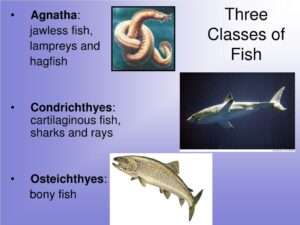Back to: Pre Vocational Studies JSS 2
Welcome to class
In our previous lesson, we learned about the meaning of fisheries. Today, we’re going to go deeper into the fascinating world of fish by exploring their classification based on their habitat and physical characteristics.
Classes of Fish Based on Habitat and Morphology
Habitat-Based Classification

Fish can be classified based on their preferred habitats:
- Freshwater Fish: These fish live in inland bodies of water, such as lakes, rivers, and streams. Examples include:
- Trout: Cold-water fish found in rivers and streams, known for their agility and fighting ability. They are prized for their delicious taste and are popular among recreational anglers.
- Carp: Bottom-dwelling fish found in ponds and lakes, known for their large size and tough scales. They are often used as bait fish or for food.
- Catfish: Nocturnal fish found in various freshwater habitats, known for their distinctive whiskers and ability to live in low-oxygen conditions. They are popular for their unique flavor and are often used in aquaculture.
- Marine Fish: These fish live in saltwater environments, such as oceans and seas. Examples include:
- Salmon: Anadromous fish that migrate between freshwater and saltwater, known for their impressive leaps and their ability to swim upstream to spawn. They are prized for their rich flavor and are an important commercial species.
- Tuna: Fast-swimming pelagic fish found in open oceans, known for their muscular bodies and torpedo-shaped bodies. They are highly migratory and are an important food source for humans and other marine animals.
- Cod: Bottom-dwelling fish found in cold, deep waters, known for their white, flaky flesh. They are a popular food fish and have been heavily fished in the past, leading to concerns about overfishing.
- Anadromous Fish: These fish are born in freshwater, migrate to the ocean to mature, and then return to freshwater to spawn. Examples include salmon and shad. Anadromous fish are fascinating creatures that undertake long and arduous journeys to reach their spawning grounds.
- Catadromous Fish: These fish are born in saltwater, migrate to freshwater to mature, and then return to saltwater to spawn. Examples include eels. Catadromous fish are less common than anadromous fish and often have unique life histories and adaptations.
Morphology-Based Classification

Fish can also be classified based on their physical characteristics:
- Bony Fish: These fish have a bony skeleton and are the most diverse group of fish. Examples include most common freshwater and marine fish. Bony fish exhibit a wide range of shapes, sizes, and colors, and can be found in almost every aquatic habitat.
- Cartilaginous Fish: These fish have a cartilaginous skeleton instead of bones. Examples include sharks, rays, and chimaeras. Cartilaginous fish are known for their distinctive appearance, with streamlined bodies, sharp teeth, and gill slits. They are important predators in marine ecosystems.
- Jawless Fish: These fish lack jaws and have a cartilaginous skeleton. Examples include lampreys and hagfish. Jawless fish are considered “living fossils” as they have remained relatively unchanged for millions of years. They are parasitic organisms that attach themselves to other fish to feed.
Conclusion
In this lesson, we’ve learned about the different ways to classify fish based on their habitat and physical characteristics. By understanding these classifications, we can gain a deeper appreciation for the diversity and complexity of the fish world. From the tiny minnows of freshwater streams to the mighty sharks of the deep ocean, fish play a vital role in our ecosystems and our lives.
Questions
- What are the two main ways to classify fish?
- Can you name the different types of freshwater fish?
- What are some examples of marine fish?
- What is the difference between anadromous and catadromous fish?
- What are the three main groups of fish based on their morphology?
We have come to the end of today’s class. I hope you enjoyed the class!
In the next class, we shall be discussing the Uses of fish and fish products
In case you require further assistance or have any questions, feel free to ask in the comment section below, and trust us to respond as soon as possible. Well done so far and See you in the next class!
